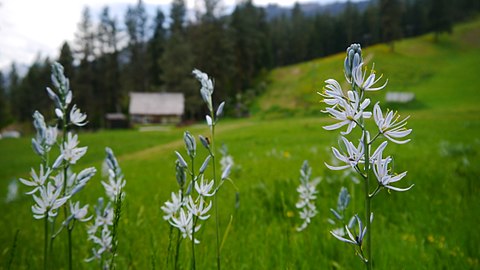Camassia quamash
| Common camas | |
|---|---|

| |
| Scientific classification | |
| Kingdom: | Plantae |
| Clade: | Tracheophytes |
| Clade: | Angiosperms |
| Clade: | Monocots |
| Order: | Asparagales |
| Family: | Asparagaceae |
| Subfamily: | Agavoideae |
| Genus: | Camassia |
| Species: | C. quamash
|
| Binomial name | |
| Camassia quamash (Pursh) Greene
| |
Camassia quamash, commonly known as camas, small camas,
Description
It is a
The pale blue to deep blue flowers appear in late spring to early summer (May to June in their native habitat). They are arranged in a raceme at the end of the stem. Each of the radially symmetrical, star-shaped flowers[5] has six tepals, about 2.5 cm (1 in) across, and six stamens.[4]
The plant and its bulbs are similar to the toxic white-flowered meadow death-camas (which is not in Camassia, but part of the genus Toxicoscordion, which grows in the same areas).[6][7]
Taxonomy

There are eight subspecies;[8]
- Camassia quamash subsp. azurea – small camas
- Camassia quamash subsp. breviflora – small camas
- Camassia quamash subsp. intermedia – small camas
- Camassia quamash subsp. linearis – small camas
- Camassia quamash subsp. maxima – small camas
- Camassia quamash subsp. quamash – common camas
- Camassia quamash subsp. utahensis – Utah small camas
- Camassia quamash subsp. walpolei – Walpole's small camas
Synonyms
The superseded name for Camassia quamash subsp. quamash, Camassia esculenta (Nutt.) Lindl.,[9] should not be confused with the superseded name Camassia esculenta (Ker Gawl.) B.L.Rob., (nom. illeg.) for Camassia scilloides.[10]
Etymology
The
Distribution and habitat

The species is
Though the once-immense spreads of camas lands have diminished because of modern developments and agriculture, numerous camas prairies and marshes may still be seen today. In the Great Basin, expanded settlement by whites accompanied by turning cattle and hogs onto camas prairies greatly diminished food available to native tribes and increased tension between Native Americans and settlers and travelers.[11] Both the Bannock and Nez Perce Wars began after Nez Perce became incensed at the failure of the US government to uphold treaties, and at settlers who plowed up their camas prairies, which they depended on for subsistence.[12][13][14][15]
Cultivation
This bulbflower naturalizes well in gardens. The bulb grows best in well-drained soil high in humus. It will grow in lightly shaded forest areas and on rocky outcrops as well as in open meadows or prairies. Additionally, it is found growing alongside streams and rivers. The plants may be divided in autumn after the leaves have withered. Additionally, the plant spreads by seed rather than by runners.
Uses
Camas is grown as an ornamental plant. Even in the wild, large numbers of camas can color an entire meadow blue-violet.
Food
The bulbs of this Camassia species are edible and nutritious when roasted or boiled,[16] but should not be confused with the toxic white-flowered meadow death-camas; the bulbs are difficult to distinguish.[6][7]
Camas has been a
Camas bulbs (and bannock made from them) are listed in the Ark of Taste.[21][22]
Gallery
-
Sunrise at Camas Prairie Centennial Park
-
C. quamash ssp. quamash
-
C. quamash at Leavenworth Ski Hill, Chelan County, Washington
-
Flowers in Corvallis, Oregon
-
Fruits
-
Seeds
References
- ^ USDA, NRCS (n.d.). "Camassia quamash". The PLANTS Database (plants.usda.gov). Greensboro, North Carolina: National Plant Data Team. Retrieved 1 February 2013.
- ISBN 978-0-88192-724-5.
- ^ BSBI List 2007 (xls). Botanical Society of Britain and Ireland. Archived from the original (xls) on 26 June 2015. Retrieved 17 October 2014.
- ^ OCLC 25708726.
- ^ a b c Karen Wiese, Sierra Nevada Wildflowers, p. 22
- ^ ISBN 978-1-55105-040-9
- ^ a b Karen Wiese, Sierra Nevada Wildflowers, p. 170
- ^ World Checklist of Selected Plant Families
- ^ World Checklist of Selected Plant Families: Camassia esculenta (Nutt.) Lindl.
- ^ World Checklist of Selected Plant Families: Camassia esculenta (Ker Gawl.) B.L.Rob.
- ISBN 0-87480-494-9
- ^ Clute, Willard Nelson (1907). The American botanist, devoted to economic and ecological botany, Volumes 11-15. W.N. Clute & co. p. 98.
- ISBN 978-0-9620782-1-7.
- ^ Native American History: The Bannock War Retrieved 1 March 2008.
- ^ Brimlow, George Francis. Harney County and Its Range Land, 1951, Binfords & Mort, Portland, Oregon, p. 102ff.
- ^ Lyons, C. P. (1956). Trees, Shrubs and Flowers to Know in Washington (1st ed.). Canada: J. M. Dent & Sons. p. 196.
- JSTOR 43996285., s.v. Camas Salish
- ISBN 0-394-73127-1.
- ISBN 0415927463.
- ISBN 978-0-8160-5971-3
- ^ Camas Bulbs, Ark of Taste, Slow Food Foundation for Biodiversity
- ^ Quamash Bannock, Ark of Taste, Slow Food Foundation for Biodiversity






